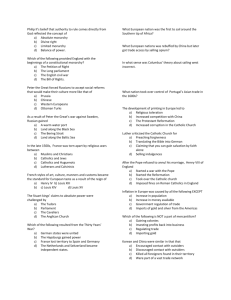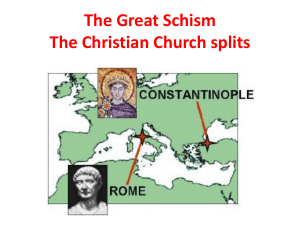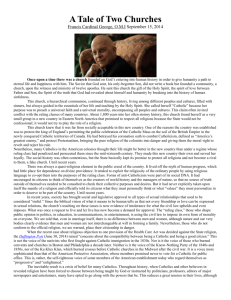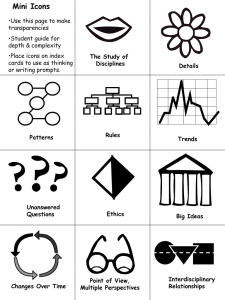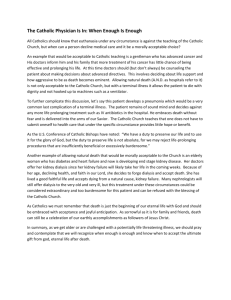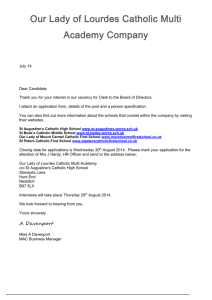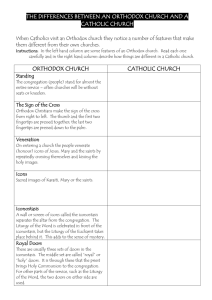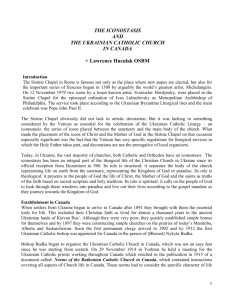Welcome to Pokrova
advertisement
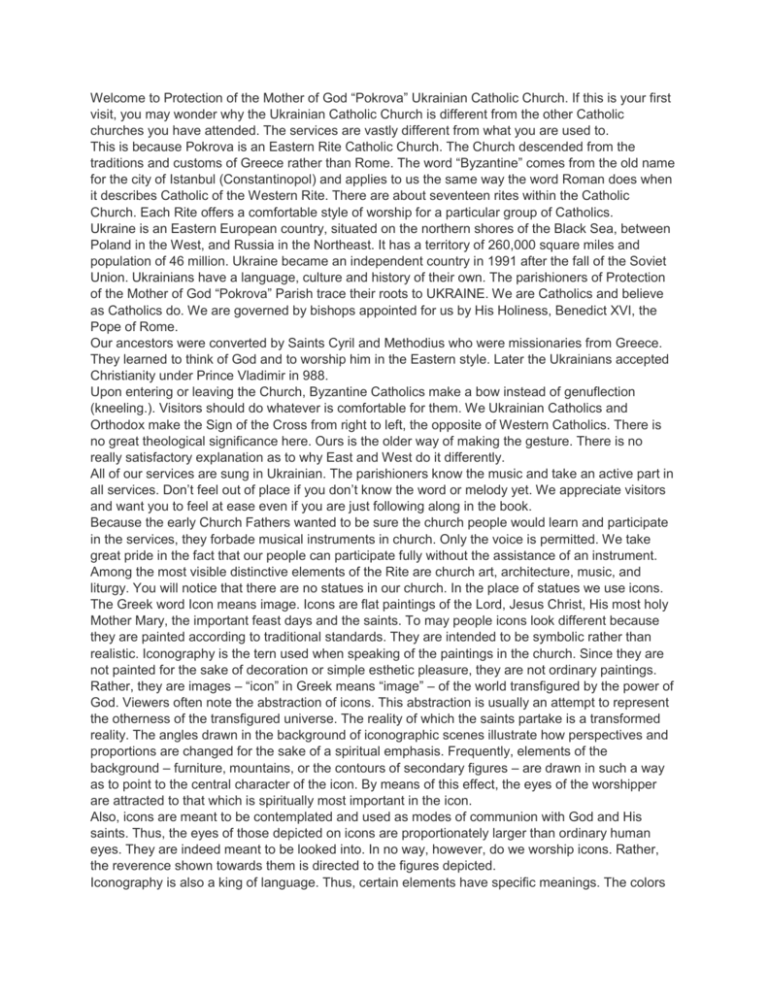
Welcome to Protection of the Mother of God “Pokrova” Ukrainian Catholic Church. If this is your first visit, you may wonder why the Ukrainian Catholic Church is different from the other Catholic churches you have attended. The services are vastly different from what you are used to. This is because Pokrova is an Eastern Rite Catholic Church. The Church descended from the traditions and customs of Greece rather than Rome. The word “Byzantine” comes from the old name for the city of Istanbul (Constantinopol) and applies to us the same way the word Roman does when it describes Catholic of the Western Rite. There are about seventeen rites within the Catholic Church. Each Rite offers a comfortable style of worship for a particular group of Catholics. Ukraine is an Eastern European country, situated on the northern shores of the Black Sea, between Poland in the West, and Russia in the Northeast. It has a territory of 260,000 square miles and population of 46 million. Ukraine became an independent country in 1991 after the fall of the Soviet Union. Ukrainians have a language, culture and history of their own. The parishioners of Protection of the Mother of God “Pokrova” Parish trace their roots to UKRAINE. We are Catholics and believe as Catholics do. We are governed by bishops appointed for us by His Holiness, Benedict XVI, the Pope of Rome. Our ancestors were converted by Saints Cyril and Methodius who were missionaries from Greece. They learned to think of God and to worship him in the Eastern style. Later the Ukrainians accepted Christianity under Prince Vladimir in 988. Upon entering or leaving the Church, Byzantine Catholics make a bow instead of genuflection (kneeling.). Visitors should do whatever is comfortable for them. We Ukrainian Catholics and Orthodox make the Sign of the Cross from right to left, the opposite of Western Catholics. There is no great theological significance here. Ours is the older way of making the gesture. There is no really satisfactory explanation as to why East and West do it differently. All of our services are sung in Ukrainian. The parishioners know the music and take an active part in all services. Don’t feel out of place if you don’t know the word or melody yet. We appreciate visitors and want you to feel at ease even if you are just following along in the book. Because the early Church Fathers wanted to be sure the church people would learn and participate in the services, they forbade musical instruments in church. Only the voice is permitted. We take great pride in the fact that our people can participate fully without the assistance of an instrument. Among the most visible distinctive elements of the Rite are church art, architecture, music, and liturgy. You will notice that there are no statues in our church. In the place of statues we use icons. The Greek word Icon means image. Icons are flat paintings of the Lord, Jesus Christ, His most holy Mother Mary, the important feast days and the saints. To may people icons look different because they are painted according to traditional standards. They are intended to be symbolic rather than realistic. Iconography is the tern used when speaking of the paintings in the church. Since they are not painted for the sake of decoration or simple esthetic pleasure, they are not ordinary paintings. Rather, they are images – “icon” in Greek means “image” – of the world transfigured by the power of God. Viewers often note the abstraction of icons. This abstraction is usually an attempt to represent the otherness of the transfigured universe. The reality of which the saints partake is a transformed reality. The angles drawn in the background of iconographic scenes illustrate how perspectives and proportions are changed for the sake of a spiritual emphasis. Frequently, elements of the background – furniture, mountains, or the contours of secondary figures – are drawn in such a way as to point to the central character of the icon. By means of this effect, the eyes of the worshipper are attracted to that which is spiritually most important in the icon. Also, icons are meant to be contemplated and used as modes of communion with God and His saints. Thus, the eyes of those depicted on icons are proportionately larger than ordinary human eyes. They are indeed meant to be looked into. In no way, however, do we worship icons. Rather, the reverence shown towards them is directed to the figures depicted. Iconography is also a king of language. Thus, certain elements have specific meanings. The colors employed, for example, are meant to convey a message. Christ, for example, is portrayed in burgundy robe covered by another blue robe. Burgundy here denotes royalty – and, by extension, divinity – while blue symbolizes humanity. Jesus is God before all ages, thus the burgundy undergarment. In His nativity, however, he takes on humanity; thus, the blue outergarment. With the Mother of God it is just the opposite. Mary is a human (blue undergarment), who takes on divinity in bearing the Son of God (burgundy outergarment). The iconostas or icon-screen is the wall directly in front of the altar with icons painted on it. It is also a distinctive element of Easter-Rite churches. It reminds us that the area around the altar is the Holy of Holies. But although the Ikonostas separates, it also unites, for the icons placed therein unite the worshipper with God. Here again placement has its symbols. On the central doors (“royal gates”) are depicted the four evangelists. The Divine Liturgy is our preferred name for the Mass. Our Holy Communion (the body and blood of Christ) is given under both forms of bread and wine using a spoon. To receive Holy Communion, approach the priest, tilt your head back and open the mouth. If you are a Catholic who ordinary receives Holy Communion in your home parish, you should feel free to receive it here. Your Sunday obligation is fulfilled by attending the Divine Liturgy (Mass) in any Rite of the Catholic Church. Catholics should experience as may of the Eastern Rites as they can. “Catholic” means universal and it is through the variety of Rites that the Church can be an example of universality. Welcome Visitors! Protection of the Mother of God “Pokrova” Ukrainian Catholic Church 9102 Meadowshire St. Houston, Texas 77037-2351 Phone: 281-447-2749
